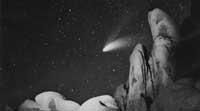Interstellar chemistry
The development of the universe and its objects has always been fascinating. Apparently, a. C. In 450 Leucipo declared that the universe was composed exclusively of stars and planets; a. C. Around 384, Aristotle published the theory of quintessence. It was the first steps of the controversy over the composition of the universe, and it was long the controversy that in 1887 Michelson and Morley, through concrete experiments, said that the quintessence or the ether did not exist, according to the denomination of the time. Leuzipo's theory was then resumed.

A few years later, Millikan and Hess changed the hypothesis until then: they discovered a radiation composed mainly of protons, which showed us that the space between planets and stars is not empty. Today we know many interstellar objects, some of them truly exotic: black holes, pulmals, quasars, etc. Many of them have also had their origin in the latest cosmological theories. One of these objects is especially interesting, since its origin is quite known, but its evolution is very confusing: we talk about clouds of interstellar gas. These objects are giant deposits of gas and dust abundant in the stars, in which synthesis reactions of many unknown molecular species occur on our planet.
Investigating how molecules occur in stars is a difficult and exciting task for current science. Thanks to microwave and radio spectroscopy, hundreds of special chemical species have been distinguished in these clouds. Clouds are quite compact, otherwise the radiation of the stars would dissociate, i.e. the molecules of those clouds. This makes us think that, although the low temperatures and densities existing in star clouds are inadequate conditions for molecular synthesis, this is the only option, since, synthesized nowhere else, radiation would dissociate into clouds. In this sense, it is believed that interstellar clouds are nurseries of molecules and the study of the formation of molecules in them is an exciting exercise for chemistry, since it is difficult in the laboratory to reproduce the conditions of this particular environment.
However, currently, using the appropriate computer and computer programs, we can simulate on the computer the conditions of compact clouds and therefore predict the development of the chemical species present in them. As in other areas, interstellar chemistry has become an indispensable tool. Moreover, in this field almost the only option is computational chemistry, since the density of these clouds (10 2 -10 7 particles/cm- 3) and low temperatures (7-20 K) are practically impossible to produce in laboratory.
Modern theories about nuclei of elements and atoms have made it possible to foresee the abundance of elements present in interstellar clouds and to understand the formation of these elements.
The most abundant heavy ions are monopositive carbon, nitrogen and oxygen among the stars, with a concentration of ten thousand of hydrogen. Keep in mind that hydrogen is the most abundant element in the universe. On the other hand, if we attend to the scale of abundance, monopositive phosphorus is one hundred million times lower than hydrogen in stars, so it is very difficult to find molecules that contain phosphorus in that medium. However, in 1987 the first was detected and in 1990 the second was detected. As a result, there was a great interest in phosphorus chemistry in the interstellar medium.
In this field the team of Dr. Ugalde has worked, who has analyzed the monopositive ion of phosphorus and its reactivity. The works carried out over the years have given the following main conclusions:
- Monoposio phosphorus does not react with methane or hydrofluoric acid. On the other hand, it is unclear whether it reacts with hydrochloric acid.
- Monopositive phosphorus reacts with compounds that form nitrogen, oxygen, silicon, sulfur and phosphorus itself with hydrogen.
- Monopositive phosphorus can react with more complex molecules, such as acetylene, methanol, and methylamine, forming complex molecules that contain phosphorus.
These works allow us to better understand the role of phosphorus in the interstellar medium. Taking into account the importance of phosphorus in the chemistry of living beings, the representativeness of these works is increased.
Project title: Phosphorus Nature Chemistry Project objective: Catio phosphorus and the formation of ions and molecules of molecules that have been found in dense clouds of nature. Director: J.M. Ugalde Working team: C. Sarasola, X. López, E. Cruz, K. Vandogen and J. Fowler Department: Dep. Science and Polymers Faculty: Faculty of Chemistry |
Buletina
Bidali zure helbide elektronikoa eta jaso asteroko buletina zure sarrera-ontzian











